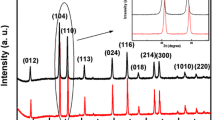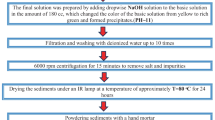Abstract
Hematite nanomaterials were obtained on thermal decomposition of (i) iron (III) citrate, (ii) 3:1 mixture of iron (III) citrate and malonic acid, and (iii) 3:1 mixture of iron (III) citrate and glucose. The average particle size (22–55 nm) of the nanomaterials was significantly affected by the co-precursor. Frequency and temperature dependence of the dielectric constant, dielectric loss and ac conductivity of these hematite nanomaterials were studied. High values of the real part of dielectric constant (\({\varepsilon }^{\prime}\)) were observed in the low-frequency region which eventually reached a frequency independent constant value above 10 kHz. A decrease in the value of \({\varepsilon }^{\prime}\) with increase in temperature and an increase in the \({\varepsilon }^{\prime}\) value with increase in the particle size were noticed. For the entire set of nanomaterials, the dielectric loss was found to have a decreasing tendency with increase in frequency with small humps at higher frequencies owing to the existence of relaxing dipoles. These nanomaterials were found to be non-Debye type and poly-dispersive. For all hematite nanomaterials, the ac conductivity followed Jonscher’s power law, and the particle-size-dependent conduction mechanisms (correlated-barrier-hopping for D = 22.5 nm and non-overlapping small polaron tunneling for D > 22.5 nm) in these nanomaterials were established. The dc conductivity values were measured as a function of temperature to confirm the semiconducting nature of these nanomaterials. The activation energy values derived from the dc conductivity studies decreased with increasing size of the nanoparticles. Analysis of the electric modulus study showed that the relaxation peaks shifted towards lower frequency with increasing temperature and found that the electrical conduction and dielectric polarization follow the same mechanism in these nanomaterials. The thermally synthesized hematite nanomaterials exhibited particle-size-dependent high dielectric constant and lower dielectric loss which highlight the synthetic method adopted as well as the synthesized materials’ suitability for applications.












Similar content being viewed by others
Data availability
Data required to reproduce these findings cannot be shared at this time as the data also form part of an ongoing study.
References
U. Schwertmann, R.M. Cornell, Iron Oxides in the Laboratory: Preparation and Characterization (John Wiley & Sons, 2008)
W. Wu, Z. Wu, T. Yu, C. Jiang, W.-S.S. Kim, Recent progress on magnetic iron oxide nanoparticles: synthesis, surface functional strategies and biomedical applications. Sci. Technol. Adv. Mater. 16(2), 23501 (2015). https://doi.org/10.1088/1468-6996/16/2/023501
H. Wan et al., Advanced hematite nanomaterials for newly emerging applications. Chem. Sci. 14(11), 2776–2798 (2023)
K.G. Gareev, Diversity of iron oxides: mechanisms of formation, physical properties and applications. Magnetochemistry 9(5), 119 (2023)
S. Kumar, M. Kumar, A. Singh, Synthesis and characterization of iron oxide nanoparticles (Fe2O3, Fe3O4): a brief review. Contemp. Phys. 62(3), 144–164 (2021). https://doi.org/10.1080/00107514.2022.2080910
M. Chakraborty, S. Kundu, B. Das, A. Bhattacharjee, Thermal transformation of 1-(ferrocenyl) ethanol to iron oxide nanoparticles based on reaction atmosphere: analysis of the decomposition reaction using non-isothermal thermogravimetry. J. Therm. Anal. Calorim. (2023). https://doi.org/10.1007/s10973-023-12306-x
S. Kundu et al., Study on co-precursor driven solid state thermal conversion of iron(III)citrate to iron oxide nanomaterials. Appl. Phys. A 129(4), 264 (2023). https://doi.org/10.1007/s00339-023-06559-4
P.S. Bassi, B.S. Randhawa, H.S. Jamwal, Mössbauer study of the thermal decomposition of iron(III) citrate pentahydrate. J. Therm. Anal. 29(3), 439–444 (1984). https://doi.org/10.1007/BF01913454
A. Srivastava, P. Singh, V.G. Gunjikar, A.P.B. Sinha, Study of the thermal decomposition of iron and. Thermochim. Acta 86(3591), 77–84 (1985)
A. Dey, M. Zubko, J. Kusz, V.R.R. Reddy, A. Banerjee, A. Bhattacharjee, Solventless synthesis and characterization of α-Fe, γ-Fe, magnetite and hematite using iron(III)citrate. Solid State Sci. 95, 105932 (2019). https://doi.org/10.1016/j.solidstatesciences.2019.105932
S.B. Narang, S. Bahel, Low loss dielectric ceramics for microwave applications: a review. J. Ceram. Process. Res. 11(3), 316–321 (2010)
M.T. Sebastian, R. Ubic, H. Jantunen, Low-loss dielectric ceramic materials and their properties. Int. Mater. Rev. 60(7), 392–412 (2015)
J.C. Papaioannou, G.S. Patermarakis, H.S. Karayianni, Electron hopping mechanism in hematite (α-Fe2O3). J. Phys. Chem. Solids 66(5), 839–844 (2005). https://doi.org/10.1016/j.jpcs.2004.11.002
J. Lian, X. Duan, J. Ma, P. Peng, T. Kim, W. Zheng, Hematite (α-Fe2O3) with various morphologies: ionic liquid-assisted synthesis, formation mechanism, and properties. ACS Nano 3(11), 3749–3761 (2009)
M. Mumtaz, M. Rajpoot, M. Ali, S. Hussain, M. Khan, Influence of graphene oxide on AC-conduction of hematite nanoparticles. Mater. Innov. 02, 26–35 (2022). https://doi.org/10.54738/MI.2022.2103
M. Qayoom, K.A. Shah, A.H. Pandit, A. Firdous, G.N. Dar, Dielectric and electrical studies on iron oxide (α-Fe2O3) nanoparticles synthesized by modified solution combustion reaction for microwave applications. J. Electroceram. 45(1), 7–14 (2020)
R. Bhat, M. Qayoom, G.N. Dar, B. Want, Improved dielectric, conductivity and magnetic properties of erbium doped α-Fe2O3 nanoparticles. J. Mater. Sci.: Mater. Electron. 30(24), 20914–20934 (2019)
K. Bindu, K.M. Ajith, H.S. Nagaraja, Electrical, dielectric and magnetic properties of Sn-doped hematite (α-SnxFe2–xO3) nanoplates synthesized by microwave-assisted method. J. Alloy. Compd. 735, 847–854 (2018)
K. Bindu, H.S. Nagaraja, Temperature-dependant phase transformation of NixFey−xOz nanoferrites: their dielectric and magnetic properties. Appl. Phys. A 125, 1–14 (2019)
K.W. Wagner, Zur theorie der unvollkommenen dielektrika. Ann. Phys. 345(5), 817–855 (1913)
J.C. Maxwell, Electric and Magnetism, vol. 2 (Oxford University Press, New York, 1973)
C.G. Koops, On the dispersion of resistivity and dielectric constant of some semiconductors at audiofrequencies. Phys. Rev. 83(1), 121 (1951)
S. Roy et al., Crystallinity mediated variation in optical and electrical properties of hydrothermally synthesized boehmite (γ-AlOOH) nanoparticles. J. Alloy. Compd. 763, 749–758 (2018)
S. Ghosh et al., Effect of size fractionation on purity, thermal stability and electrical properties of natural hematite. J. Electron. Mater. 50, 3836–3845 (2021)
S. Bardhan et al., Microstructure and dielectric properties of naturally formed microcline and kyanite: a size-dependent study. Cryst. Growth Des. 19(8), 4588–4601 (2019)
A.J. Bosman, E.E. Havinga, Temperature dependence of dielectric constants of cubic ionic compounds. Phys. Rev. 129(4), 1593 (1963)
S. Ganguly, K. Halder, N. Haque, S. Das, S. Dastidar, A comparative study between electrical properties of bulk and synthesized nano material of zinc sulphide. Am. J. Res. Commun. 3(3), 1–13 (2015)
P. Thakur, A. Kool, B. Bagchi, N.A. Hoque, S. Das, P. Nandy, RSC Advances Improvement of electroactive b phase nucleation loaded poly (vinylidene fluoride) thin films. RSC Adv. 5, 62819–62827 (2015)
A.Y. Yassin, Dielectric spectroscopy characterization of relaxation in composite based on (PVA–PVP) blend for nickel–cadmium batteries. J. Mater. Sci.: Mater. Electron. 31(21), 19447–19463 (2020)
R.L.S. e Silva, P. Banerjee, A.F. Júnior, Functional properties of donor-and acceptor-co-doped high dielectric constant zinc oxide ceramics. Phys. Chem. Chem. Phys. 21(18), 9456–9464 (2019)
M. Iacob et al., Iron oxide nanoparticles as dielectric and piezoelectric enhancers for silicone elastomers. Smart Mater. Struct. 26(10), 105046 (2017)
Q. Chi et al., Enhanced thermal conductivity and dielectric properties of iron oxide/polyethylene nanocomposites induced by a magnetic field. Sci. Rep. 7(1), 1–11 (2017)
M. Tahir, M. Fakhar-e-Alam, M. Atif, G. Mustafa, Z. Ali, Investigation of optical, electrical and magnetic properties of hematite α-Fe2O3 nanoparticles via sol-gel and co-precipitation method. J. King Saud Univ.-Sci. 35(5), 102695 (2023)
N.B. Gatchakayala, R.S.R. Dachuru, Synthesis, magnetic, AC conductivity and dielectric properties of hematite nanocrystallites. Phys. Chem. Solid State 24(2), 244–248 (2023)
K.S. Cole, R.H. Cole, Dispersion and absorption in dielectrics I. Alternating current characteristics. J. Chem. Phys. 9(4), 341–351 (1941). https://doi.org/10.1063/1.1750906
M. Goyal, A model to determine variation in dielectric constant with size and composition in semiconducting nanosolids. J. Comput. Electron. 21(6), 1212–1219 (2022)
S. Anand, V.M. Vinosel, M.A. Jenifer, S. Pauline, Dielectric properties, ac electrical conductivity and electric modulus profiles of hematite (α-Fe2O3) nanoparticles. Int. Res. J. Eng. Technol. 4, 358 (2017)
M.N. Siddique, T. Ali, A. Ahmed, P. Tripathi, Enhanced electrical and thermal properties of pure and Ni substituted ZnO Nanoparticles. Nano-Struct. Nano-Objects 16(June), 156–166 (2018). https://doi.org/10.1016/j.nanoso.2018.06.001
B. Sahoo, S.K. Sahu, S. Nayak, D. Dhara, P. Pramanik, Fabrication of magnetic mesoporous manganese ferrite nanocomposites as efficient catalyst for degradation of dye pollutants. Catal. Sci. Technol. 2(7), 1367–1374 (2012). https://doi.org/10.1039/C2CY20026K
S.A. Saafan, S.T. Assar, Dielectric behavior of nano-structured and bulk Li Ni Zn ferrite samples. J. Magn. Magn. Mater. 324(19), 2989–3001 (2012). https://doi.org/10.1016/j.jmmm.2012.04.037
A. Dhahri, E. Dhahri, E.K. Hlil, Electrical conductivity and dielectric behaviour of nanocrystalline La0.6Gd0.1Sr0.3Mn0.75Si0.25O3. RSC Adv. 8(17), 9103–9111 (2018)
A.K. Jonscher, Universal Relaxation Law: A Sequel to Dielectric Relaxation in Solids (Chelsea Dielectrics Press, 1996)
H. Chouaibi, J. Khelifi, A. Benali, E. Dhahri, M.A. Valente, A. Koumina, Improved conductivity and reduced dielectric loss of Cu- substituted NiFe2O4 for high frequency applications. J. Alloys Compd. 839, 155601 (2020). https://doi.org/10.1016/j.jallcom.2020.155601
M. Ben Bechir, K. Karoui, M. Tabellout, G. Kamel, A. Rhaiem, Electric and dielectric studies of the [N(CH3)3H]2CuCl4 compound at low temperature. J. Alloys Compd. 588, 551–557 (2014). https://doi.org/10.1016/j.jallcom.2013.11.141
K. Kahouli, A.B.J. Kharrat, K. Khirouni, S. Chaabouni, Electrical conduction mechanism and dielectric properties of the [C13H16N2]5(BiCl6)3Cl hybrid compound. Appl. Phys. A 129(6), 431 (2023)
V. Sharma et al., Phase transformation in Fe2O3 nanoparticles: electrical properties with local electronic structure. Physica B 620, 413275 (2021)
F. Ahmad, A. Maqsood, Structural, electric modulus and complex impedance analysis of ZnO at low temperatures. Mater. Sci. Eng., B 273, 115431 (2021)
S.F. Chérif, A. Chérif, W. Dridi, M.F. Zid, Ac conductivity, electric modulus analysis, dielectric behavior and bond valence sum analysis of Na3Nb4As3O19 compound. Arab. J. Chem. 13(6), 5627–5638 (2020)
H.M.T. Farid, I. Ahmad, I. Ali, S.M. Ramay, A. Mahmood, G. Murtaza, Dielectric and impedance study of praseodymium substituted Mg-based spinel ferrites. J. Magn. Magn. Mater. 434, 143–150 (2017)
S. Chahal, A. Kumar, P. Kumar, Zn doped α-Fe2O3: an efficient material for UV driven photocatalysis and electrical conductivity. Crystals 10(4), 273 (2020)
M. Bourguiba, Z. Raddaoui, A. Dhahri, M. Chafra, J. Dhahri, M.A. Garcia, Investigation of the conduction mechanism, high dielectric constant, and non-Debye-type relaxor in La 0.67 Ba0.25 Ca0.08MnO3 manganite. J. Mater. Sci.: Mater. Electron. 31, 11810–11818 (2020)
H. Mansour et al., Structural, optical, magnetic and electrical properties of hematite (α-Fe2O3) nanoparticles synthesized by two methods: polyol and precipitation. Appl. Phys. A 123(12), 787 (2017). https://doi.org/10.1007/s00339-017-1408-1
F. Le Formal, N. Tetreault, M. Cornuz, T. Moehl, M. Grätzel, K. Sivula, Passivating surface states on water splitting hematite photoanodes with alumina overlayers. Chem. Sci. 2(4), 737–743 (2011)
H.A. Kramers, L’interaction entre les atomes magnétogènes dans un cristal paramagnétique. Physica 1(1–6), 182–192 (1934)
K.M. Rosso, D.M.A. Smith, M. Dupuis, An ab initio model of electron transport in hematite (α-Fe2O3) basal planes. J. Chem. Phys. 118(14), 6455–6466 (2003)
Acknowledgements
SK is thankful to DST-INSPIRE, Government of India for providing a fellowship. The authors express thank to Mr. G. Ghorai and Dr. P. K. Sahoo of NISER-Bhubaneswar, Jatni, India for providing powder XRD data.
Author information
Authors and Affiliations
Contributions
Material preparation, major data collection, and analysis were performed by SK. TS was involved in some data collections. AB conceptualized the problem and designed the study. The first draft of the manuscript was written by SK and finalized by AB. All authors reviewed the final manuscript.
Corresponding author
Ethics declarations
Conflict of interest
Authors declare that they have no conflict interest.
Additional information
Publisher's Note
Springer Nature remains neutral with regard to jurisdictional claims in published maps and institutional affiliations.
Supplementary Information
Below is the link to the electronic supplementary material.
Rights and permissions
Springer Nature or its licensor (e.g. a society or other partner) holds exclusive rights to this article under a publishing agreement with the author(s) or other rightsholder(s); author self-archiving of the accepted manuscript version of this article is solely governed by the terms of such publishing agreement and applicable law.
About this article
Cite this article
Kundu, S., Sarkar, T. & Bhattacharjee, A. Dielectric and electrical characterization of hematite (α-Fe2O3) nanomaterials synthesized by thermal decomposition of iron(III)citrate. Appl. Phys. A 129, 723 (2023). https://doi.org/10.1007/s00339-023-07000-6
Received:
Accepted:
Published:
DOI: https://doi.org/10.1007/s00339-023-07000-6




